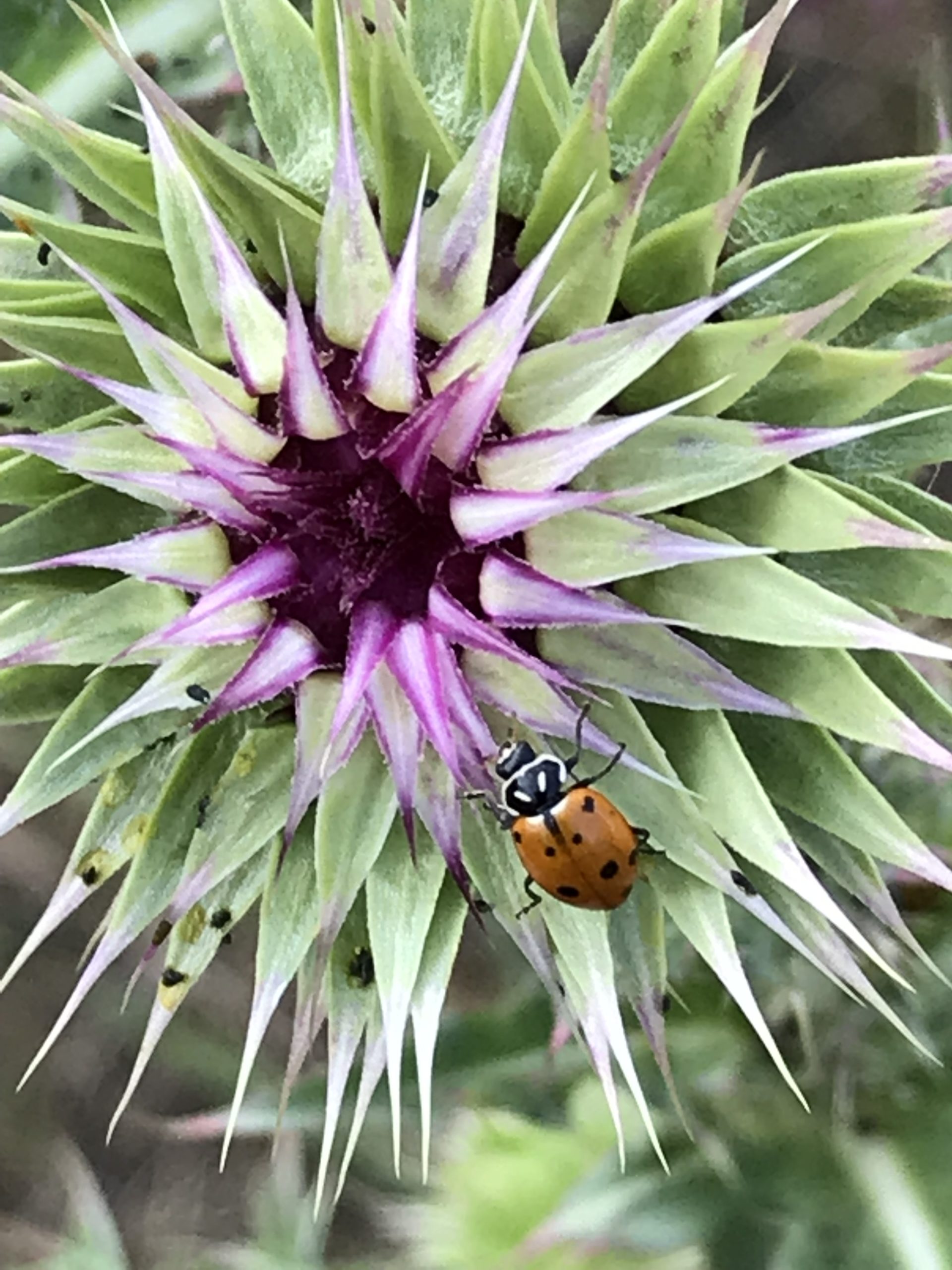
Courtesy & © Shannon Rhodes, Photographer
 Musk Thistle
Musk Thistle
Courtesy & © Shannon Rhodes, Photographer
 A Child’s Spotted Knapweed Nature Journal
A Child’s Spotted Knapweed Nature Journal
Courtesy & © Shannon Rhodes, PhotographerMy mother’s mother loved the wonder of the natural world, from eye-catching minerals to how lightning drags thunder behind it like a garden cart. Grandma Eda asked that thistle be a prominent flower at her funeral. I’ve always been struck by how she saw past the prickly spikes to find beauty in the flower I know as a weed, certainly a metaphor for how she saw her life.
Butterflies, bees, and beetles love thistle. Hummingbirds, and other birds, especially goldfinches, do as well. There’s even a story of an explorer named Truman Everts who in 1870 survived on elk thistle root for more than a month as he wandered lost in what would become Yellowstone National Park a few years later.
Not everyone, however, sees thistles and their knapweed lookalikes of the Aster family the same affectionate way. Wildlife and livestock find most unpalatable, and they certainly can be a spiny nuisance as one moves past them in the field. There are some native thistles, but the Utah Noxious Weed Act code 4-17 designates Canada thistle, musk thistle, nodding thistle, plumeless thistle, and Scotch thistle, as well as spotted knapweed and other knapweeds as either species to be controlled or contained to halt their spread. These invasive non-native weeds prolifically reproduce and aggressively crowd out native plants.
Fortunately, there is hope in the noxious weed battle beyond herbicides and handpicking. A creative partnership of Utah’s Division of Wildlife Resources, Weed Supervisors Association, and Cache County Weed Department have been working with Edith Bowen Laboratory School students at Hardware Ranch Wildlife Management Area for several years. They use weevils to eradicate the noxious weeds from the tons of hay grown in the meadow and surrounding areas that is then used to feed the elk each winter. This program called Kids in Action: Going Wild With Science engages children and adult scientists and other professionals as they gather data and do service learning with native and non-native plants and insects for the benefit of the elk and the greater community.
As a partnering educator, I have assisted fourth grade students as they sample sites in the meadow and along nearby Curtis Creek with these partnering adults, gathering data on the prevalence and health of Canada thistle as a way to determine the effectiveness of a biocontrol species, the Hadroplontus litura, that have been released in the area previous years. This stem-boring weevil literally bores into the stem of the Canada thistle plants and eats the inner tissue, killing the plants and leaving behind insect larva excrement called frass. They have done similar projects targeting spotted knapweed, and it is the best kind of citizen science where students are able to see results as they learn, even if Grandma would scold me for meddling with her beloved wild purple Mother’s Day bouquets.
For Wild About Utah, I’m Shannon Rhodes.
Credits:
Images: Courtesy & Copyright Shannon Rhodes, Photographer
Additional Audio: Courtesy & © Kevin Colver https://wildstore.wildsanctuary.com/collections/special-collections
Text: Shannon Rhodes, Edith Bowen Laboratory School, Utah State University https://edithbowen.usu.edu/
Additional Reading Links: Shannon Rhodes
Additional Reading:
Anderson, Mike. Cache Valley Students Get Work as Biologists for a Day at Hardware Ranch. Sept. 1, 2016. KSL News. https://www.youtube.com/watch?v=TkZaHNTMxOU
Bengston, Anna. Trouble with Tumbleweeds. May 9, 2014. https://wildaboututah.org/trouble-with-tumbleweeds/
Dzurisin, Dan. What’s in a Name? The Misadventures of Truman Everts. 2019. https://www.usgs.gov/news/whats-name-misadventures-truman-everts
Eckberg, James et al. Native Thistles: A Conservation Practitioner’s Guide. 2017. https://xerces.org/sites/default/files/2018-05/16-029_01_XercesSoc_Native-Thistles-Conservation-Guide_web.pdf
Green, Jack. Pioneer Day Edible Native Plants. July 13, 2015. https://wildaboututah.org/pioneer-day-edible-native-plants/
Hellstern, Ron. Invasive Species. Sept. 24, 2018. https://wildaboututah.org/invasive-species/
Hoopes, Carla. Kids in Action for Biological Control. January 2021. https://bugwoodcloud.org/bugwoodwiki/archive/20210216140118!KIA_Initiative_Who_We_Are.pdf and https://bugwoodcloud.org/bugwoodwiki/EBLS_2020_Report.pdf
Lowry, Brenda Jarvis et al. Noxious Weed Field Guide for Utah. Utah State University Extension. 2017. https://digitalcommons.usu.edu/cgi/viewcontent.cgi?article=2351&context=extension_curall
Mendenhall, Amber. Hardware Ranch Student Biocontrol Program. 2020. https://utahweedsupervisors.com/hardware-ranch-student-biocontrol-program/
Mendenhall, Morgan. Common Weeds of Utah Forests. https://forestry.usu.edu/files/utah-forest-facts/common-weeds-of-utah-forests.pdf
Utah Department of Agriculture. Utah Noxious Weeds. 2020. https://www.invasive.org/species/list.cfm?id=33 https://www.invasive.org/species/list.cfm?id=33
Winston, Rachel et al. Biology and Biological Control of Exotic True Thistles. U.S. Forest Service Forest Health Technology Enterprise Team. https://www.fs.fed.us/foresthealth/technology/pdfs/ExoticTrueThistles.pdf
